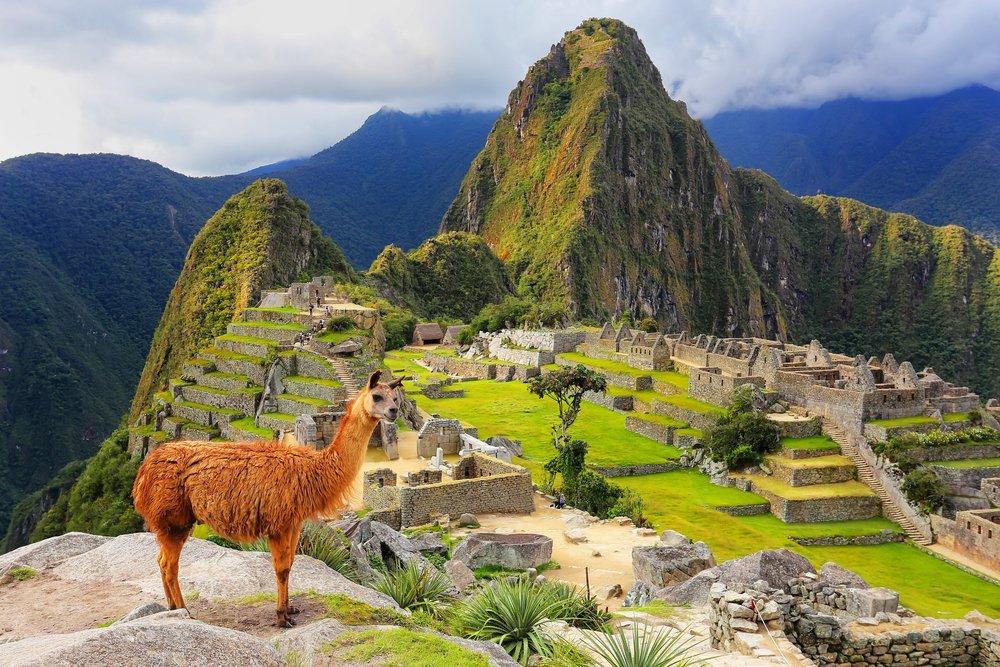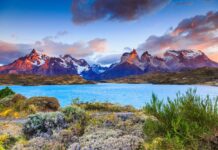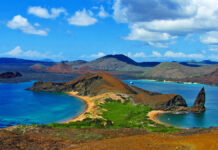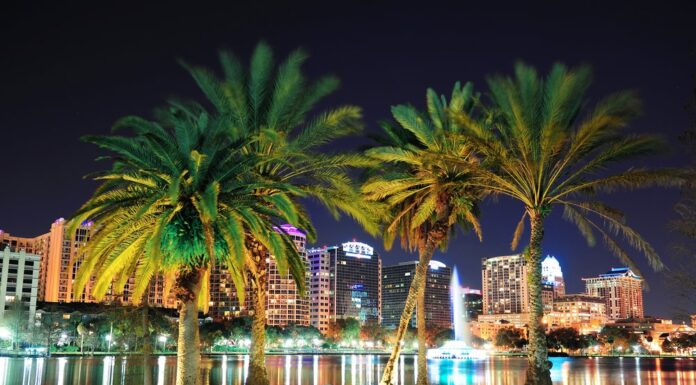A stretch of ancient gems, lush rainforests, and historical heirlooms put Peru on the map of every traveler. From an elaborate display of architecture to majestic sea and mountains capes, the top attractions in Peru give you unending access to all sorts of adventure, making it one of the most bucket-list-worthy countries in South America.
So prepare your IG feed because this beautiful archipelago will give your followers something to feast on–a concoction of nature, culture, and history, topped with a delish bowl of delish Peruvian dish.
What to Expect When You Travel to Peru
Currency: Nuevo sol (S/)
Language: Spanish is the main language used in Peru, but there are two other languages commonly used in the country: Aymara and Quechua
Transportation: Like most South American countries, there are limited train lines in Peru. Traveling by bus is a cheap and convenient way to get between cities, but you can also rent a car or book a private taxi. If you want to cut travel times, you can quickly fly between the top attractions in Peru by booking a domestic flight.
Time Zone: GMT-5
Socket: Type A and Type C
Weather: As the third-largest country in South America, the weather in Peru is region-dependent. The tropical jungle region is humid all-year-round, with humidity levels escalating from December to March. Meanwhile, the coastal side, which covers its desert areas, experiences a dry and hot climate all year, with temperatures that can peak to 45°C between December and April. Into the highlands, the climate is divided into two: dry and wet. The dry season runs from April to November while the wet season is experienced the rest of the year.
Best Travel Times: Peru is a huge country that offers diversity to travelers. Before booking a plane ticket, decide on the regions you want to visit first to make sure you’d be able to maximize your trip. As a general rule, January to April is the wettest season in the country, so if you want to go mountain hiking, this isn’t the best time to go. Amazon’s peak travel period runs from June to November since there is less rainfall during these months and most trails are open.
Peru Travel Guide: Traveling on a Budget–or Not
Spend weeks backpacking Peru and you’d barely scratch its surface. Its beauty is remarkable, but just like traveling to other tourist destinations, a luxurious trip comes with a price tag. Luckily, traveling to Peru on a budget is possible, thanks to its wide range of accommodation options. Here’s a breakdown of some of the major travel expenses you need to prepare for if you’re up for either a budget or a luxurious trip:
- Peru Hotels and Hostels: Let’s start with our low-cost options. Many hostels in Peru fall between $12 to $15 per night, but you can also spot a few dorm rooms that charge only $7 a night. The rates for 2-star Peru hotels and private rooms, on the other hand, range between $20 to $45. For a more luxurious stay, you can easily find 5-star Peru hotels in Lima, which charge around $170 per night.
- Food: The cost of an authentic Peruvian food crawl is different for every region, but one thing is for sure: the country’s range of specialties is a world of diverse gastronomic adventures. Street food is rampant in Peru, with food options that cost anywhere between $1 and $2. Budget meals that cost only $3 are also available outside major cities. But if you want something a bit mid-range, many local restaurants here offer meals at $6 to $15. For an extended trip, you can cook your own dishes. Doing so will cost you around $45 to $50 per week.
- Travel Activities: With many low-cost Peru hotels and food options available in the country, traveling to Peru on a budget is quite an easy feat. But if there’s anything that can take a huge toll on your budget, it’s taking a trip to some of its prime tourist sites. A trip to the phenomenal Inca Trail can cost $100, while a visit to Machu Picchu can cost over $50. While these sites are a must-visit, there are also budget-friendly museums that charge only around $10 per entry.
Overall, your travel cost greatly depends on your travel priorities. While backpacking can cut your expenses to about $40 per day, you’d have to skip on some of the top attractions in Peru to go within this budget range. This also means you have to scratch out Peru hotels on your bucket list.
A mid-range trip that includes admission to some of its major attractions can cost you over $130. But if you don’t mind the occasional splurge, a luxurious trip with domestic flights and a stay at 5-star Peru hotels can cost you more or less $300 per day.
Insider Tips: How to Save Money When Visiting the Top Attractions in Peru
Travel Off-Peak
Traveling off-peak is for the adventurous soul, especially if we’re talking about hiking in Peru’s mountainous regions. But if you don’t mind the rain showers and the muddy trails, travel to Peru between April to May to score great travel deals.
Look for Family-Owned Peru Hotels or Register at Couchsurf
Staying at family-run hotels or hostels is perhaps one of the most budget-friendly ways to visit Peru. But if you’re after a free stay, you can also register an account at Couchsurf. The Couchsurfing community in Peru is active, and it gives you a great opportunity to meet locals. However, it’s important to check out your co-Couchsurfer’s references first. While Couchsurfing is generally safe, there are always some who can spoil the experience.
Eat with the Locals
Food in Peru is cheap, but it can be cheaper if you know where to find the eateries frequented by locals. Many restaurants in hot travel spots like Cusco, Lima, and Arequipa charge higher than less-known Peruvian food hubs. Look for streets that house low-range restaurants and choose set meals that are only around $3 per meal.
Watch the Bus and Taxi Rates
Your negotiating skills can take you places, especially if you need to hail a taxi. Taxis in Peru don’t run meters, so make sure to agree on a fixed price before getting in–unless you want to fall in a pricey trap. It also pays to ask locals for typical taxi rates from point A to point B to get an idea of taxi rates.
When hopping on a bus, on the other hand, make sure to compare bus prices. Some popular bus companies charge double for an express trip with extra food services. If you don’t mind making occasional stop-overs, go for the less fancy buses. Collectivos, for one, is a local bus company that charges low rates.
Don’t Book in Advance
Unlike other travel destinations that offer early-bird deals, booking tours in top attractions in Peru ahead of time has its pros and cons. Booking in advance secures you a slot, but you’d have to pay premium charges.
If you’re a risk-taker, you can book your tours a few days before your visit or just show up on the day. It’s a gamble, but if you’re lucky enough to get a last-minute reservation, you can get an enormous discount. Also, instead of booking your tours online, it’s more cost-efficient to look for a local agency that offers the same tours at half the price you’d see online.
Top Attractions in Peru: Must-See Sights for an Unforgettable Trip
Lima
🛪 Lima is home to Peru’s main domestic and international airport, the Jorge Chavez International Airport. If you book a flight here, it would only take a few trips to arrive at your hostel/hotel.
To say that Lima is beautiful is an oversight. As the world’s second-largest desert capital, Lima is overflowing with Peruvian culture, arts, and history, making it one of our top bucket list staples. Locally known as the City of the Kings, Lima shows you a great assortment of artsy murals and colonial architecture.
If it’s your first time visiting Peru, don’t forget to check out Juaca Pucllana, which showcases the ruins of a pre-Incan pyramid. To complete your trip back to history, visit Museo Larco, where you can see ancient collections that feature the work of indigenous people. The coastal views in Miraflores and Parque del Amor also make Lima one of the top attractions in Peru.
But while the great balance of culture, architecture, and nature make Lima a must-visit city, its greatest asset is its eclectic food scene. Here, you’ll spot restaurants that offer the most mouth-watering dishes like Pescados Capitales, El Mercado, and Canta Rana. As if the parmesan scallops and the fresh calamari from these top-rated food hubs aren’t enough, you can also indulge in local street food that is as delicious as it is inexpensive.
Cusco
🛪 Considering that Lima is the main entryway to Peru, there are two ways you can get to Cusco from Lima: 1) book a 55-minute domestic flight or 2) brave the roads and travel 20 hours (or so) by bus.
A high-altitude city worth every minute of your Peruvian visit, Cusco remains to be one of the top attractions in Peru for its century-old architecture and its impressive buildings. While most travelers see Cusco as a jump-off point to Machu Picchu, its unique identity will keep you marveling around its corners.
Locally known as the “Navel of the World,” Cusco was the capital of the Inca Empire. The buildings that were inhabited by the chosen women of Inca who were under a vow of chastity are now the dwelling place of nuns. But aside from these religious landmarks, what makes Cusco unforgettable is its architecture. In the city, you’d see large walls that pay homage to early civilization, along with beautiful cathedrals and ancient artworks.
Some of the most-visited sites in Cusco include the Compañía de Jesús and the Calle Hatunrumiyoc. The Plaza de Armas, which serves as the city’s main square, is a great spot to people-watch. Around the plaza, you’ll see exciting restaurants and shops, making it perfect for souvenir shopping. The Cusco Cathedral, a UNESCO Heritage Site, also sits within the perimeter of the square. Enter the cathedral and you’d find rare archeological jewels and colonial artworks.
If you’re done roaming around Cusco, you can also arrange a trip to the world-renowned Rainbow Mountain. It’s a 3-hour ride from Cusco, and you’d have to hike your way to see its picturesque views. It’s one of the high-altitude top attractions in Peru that’s worth the extra mile.
The Sacred Valley of the Incas
🛪 If you’re from Lima, you can book a domestic flight to Cusco. From there, you can take a bus ride to the Sacred Valley of the Incas.
The Sacred Valley of the Incas, locally called the Río Urubamba Valley, is a stunning 70-mile stretch that runs between the historic Cusco and the mystifying Machu Picchu. With an altitude lower than Inca Trail’s, the Sacred Valley is a great place to start getting acclimatized before beginning your Machu Picchu adventure.
Lush forests, ancient agricultural landscapes, and majestic river valleys welcome tourists as they arrive at the Sacred Valley. But aside from its otherworldly gifts, the valley is also home to a close-knit Quechua-speaking community. Here, you can immerse yourself in a unique culture and witness some of the oldest traditions that have been well-preserved by locals–weaving textiles, included.
A surreal experience that gives you a sneak peek of Inca’s ancient culture, the Sacred Valley flaunts a laid-back community. Explore its amazing greeneries riding a horse, a bike, or on foot–the sky’s the limit as far as wandering is concerned, but don’t forget to pause, relax, and sight-see on a hammock afterward. Exploring the valley for days can give you an enormous advantage, especially if you plan to hike to Machu Picchu (which you definitely should).
The Inca Trail
🛪 You can get to the Inca Trail by taking a train from Cusco. It’s best to book your tickets online to reserve a seat. All tours Inca-Trail and Machu-Picchu-related sell out fast, so booking last minute is a huge gamble.
A perfect blend of amazement, adrenaline rush, and a sense of fulfillment sum up a hike to the Inca Trail. Basically a four-day trek that ends at Machu Picchu, the Inca Trail is built for intrepid hikers. A travel highlight for many backpackers, this exciting adventure comes with days of hard work and persistence. Although the trail is quite rough around the edges, the guided tours make the hike easier.
The trail starts at the Cusco-Aguas Calientes rail line. The hike gets you past majestic sceneries of Inca ruins and picturesque mountainscapes. While the trek up the Dead Woman’s Pass is exhausting, and it is followed by a drop to a stone pathway. Overall, day 2 of the hike is all about crawling up with all your might. Day 3, on the other hand, is a descending trail. Come day 4 and you’d reach Sun Gate, which leads you to the stunning Machu Picchu.
The Inca Trail is, without a doubt, a physically-challenging feat. The ultimate reward: the jaw-dropping view of Machu Picchu, which makes every drop of sweat worth it. If your mind and muscles are up for it, taking over the Inca Trail is a great, once-in-a-lifetime experience. Just book your guided tours in advance so you won’t miss out on taking this trail.
Machu Picchu
🛪 Getting to Machu Picchu is not for the faint of heart, but before trekking to this enigmatic landscape, you should get to Cusco first. From there, you can book a train ride to Aguas Calientes, which runs past the Sacred Valley.
Sitting 2,430 meters above sea level is the enchanting Machu Picchu, an archeological wonder that unfailingly leaves tourists in a trance. This engineering genius is enveloped with mystery as it was meticulously built back in ancient times when mortars and metals were yet to be discovered. Why it was built and why it was abandoned are questions that are still looking for answers.
Climbing Machu Picchu is like opening a door to a new dimension. This astonishing fortress, which is nestled between sky-high mountainscapes, is made up of storehouses and temples. Some say it was a place of retreat, while earlier studies reveal that it was built for religious ceremonies. Today, the Machu Picchu is hailed as one of the New 7 Wonders of the World–a crown it truly deserves given its exquisite, out-of-this-world beauty.
Insider tip: Given Machu Picchu’s height, it’s important to get acclimatized in lower-altitude areas (like the Sacred Valley) before hiking to its peaks. Also, if you’re heart is dead set on exploring this extraordinary gem, you should make enough room in your budget because a visit to this site is anything but cheap. A train ride from Cusco can cost over $100, and this is not inclusive of entry fees, which can go over $60. Add to that are bus trips to and from the Inca slope that usually cost $24, but if you love hiking, you can skip the bus and climb the slope for free.
As a final word of warning, the 90-minute hike to Machu Picchu is strenuous, so bring all your hiking essentials. Walking sticks, drones, and umbrellas are prohibited in the area, except if: a) you need them, and b) their tips are covered in rubber. The climate is temperamental, too, so dress in layers and don’t forget to bring a raincoat.
The Peruvian Amazon
🛪 The easiest way to get to the Peruvian Amazon is by flying to Puerto Maldonado. If you prefer traveling by land, you can choose from either of these two jump-off points: Cusco or Lima. From Cusco, you can book an 11-hour bus ride to Puerto Maldonado. Alternatively, you can travel from Lima to Puerto Maldonado by bus, but this will double your travel time. Once you’re in Puerto Maldonado, a 5-hour boat ride will take you to the Amazon.
The Amazon is no stranger to us, thanks to Holywood films and travel documentaries. Perhaps one of the most undisputed top attractions in Peru, the Amazon is everything raw and exemplary. It covers over half of the country, and it continues to draw backpackers and adventurers to South America. Why? Aside from its virgin rainforests, the Amazon screams diversity. Here, you can get up close with wildlife and if you’re lucky enough, you might even come across an anaconda. Specialized anaconda expeditions don’t guarantee you a sighting. But even if you don’t see one, you’d surely find rare animals in Amazon’s remote areas.
Adding to a long list of Amazonian adventures is guided night walk tours that take you further into the jungle. You can sign up for canopy walks and twilight river tours. Also, don’t forget to visit Lake Sandoval where you can see rare howler monkeys and river otters.
A word of caution–a visit to the Amazon is not child’s play. A jungle that begs to be explored, this side of Peru is made for intrepid hikers and travelers. Pack light and don’t forget to bring emergency meds if you plan to stay overnight.
Speaking of overnight stays, you won’t find five-star Peru hotels here. Many huts and lodges charge over $400 per night, and anything below that is already a great deal. If you have the heart and the budget, a weekend stay at this jungle is worth a lifetime of adventures.
Final Thoughts
A country that offers you a full spectrum of activities, Peru is your bridge to out-of-this-world experiences. From groundbreaking architecture to thriving flora and fauna, the top attractions in Peru are a dream destination of seasoned travelers.
With so many travel opportunities in one archipelago, it’s wise to give yourself enough time to explore its many gifts. Pack light. Pack right. And don’t forget to pause and appreciate the exquisite Peruvian beauty.









[…] Machu Pichu in the Cuzco Region of Peru […]
Comments are closed.